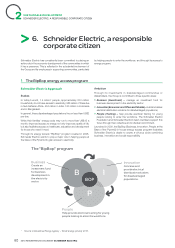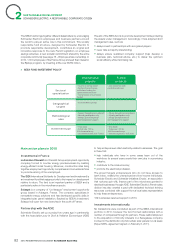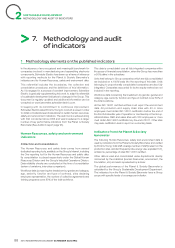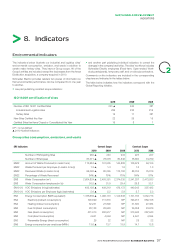APC 2010 Annual Report Download - page 91
Download and view the complete annual report
Please find page 91 of the 2010 APC annual report below. You can navigate through the pages in the report by either clicking on the pages listed below, or by using the keyword search tool below to find specific information within the annual report.
SUSTAINABLE DEVELOPMENT
METHODOLOGY ANDAUDIT OFINDICATORS
30,000T annual reduction of our C02 equivalent
emissions
This indicator includes:
•direct greenhouse gas emissions, i.e. emissions of SF6 in the
industrial sites concerned;
•indirect emissions associated with energy use of industrial and
logistics sites and a part of the most signifi cant tertiary sites
(electricity, gas, fuel, diesel, urban heating);
•indirect emissions, related to long distance freight.
The emissions associated with these activities are converted into
CO2:
•in the ratio of 23,900kg of CO2 for 1kg of SF6 used by the
International Energy Agency (IAE);
•in energy to CO2 ratios of the IEA. Figures are taken for the One
program period (2009-2011). These conversion factors can be
global (gas, fuel, diesel) or national (electricity, urban heating).
In 2010, this scope was extended:
•the number of sites reporting their energy use increased from 244
sites in 2009 to 251 in 2010;
•air and sea fl ows tracked cover 76% of all air and sea fl ows form
the Group, as opposed to around 40% previously.
These changes will take effect to compare the emissions of 2011
with those of 2010.
The indicator compares the equivalent CO2 volume released in year n
with the equivalent CO2 volume that the Group would have released
on a comparable basis without making any effort to cut its emissions.
For instance, the effort made to make the industrial processes safe
that use SF6 enabled the leakage rates of SF6 to be cut in year n
compared with year n-1; without this effort, it is considered that the
leakage rates would have been equivalent in year n and in year n-1.
Each of the three indicator components above were audited by Ernst
& Young. The indicator was not audited because the comparison of
energy use over two years, to calculate a cut in emissions, requires
temperature variations to be neutralised on a comparable basis,
which we are not yet in a position to calculate precisely: an action
plan to do so is currently being prepared for2011.
2/3 of our products revenues achieved with Green
Premium products
A Green Premium product is defi ned by the following four criteria:
•an Environmental Product Profi le available online;
•an end-of-life instruction manual available online;
•the list of substances of concern according to the European
Directive REACH available online;
•the observance of the content limits imposed for some
substances by the RoHS EU Directive.
The indicator measures the share of sales made with a Green
Premium offer from sales fi gures for 2008; and sales made by “core”
offers from the Group representing around 50% of product sales.
The indicator does not measure, therefore, products adapted to local
market requirements and for which the environmental impacts could
vary from those of the core range.
This indicator was audited by Ernst & Young.
2/3 of our employees work on ISO14001 certified sites
ISO14001 is an international standard certifying the environmental
management systems of sites.
The sites purchased in 2010 after the purchase of the Areva
Distribution business are not included.
The indicator’s denominator recognises those under contract with
Schneider Electric (fixed-term and open-ended contracts) and
temporary staff (all of the Group employees) and its numerator
those under contract with Schneider Electric (fi xed-term and open-
ended contracts), the temporary staff and subcontractors from the
ISO14001 certifi ed sites. The indicator is thus increased.
This indicator was audited by Ernst & Young.
Exceeding the Group’s growth by 7points per year
with our energy efficiency activities
The energy effi ciency activities are products, services and solutions
sold by the Group contributing to at least one of the four stages of
active energy effi ciency (measure, optimise, monitor, improve). Their
choice in the Group’s offer is validated in Executive Committee.
The 2010 exchange rate is applied to sales achieved in 2009 to
calculate the growth in sales of the Group and energy effi ciency
activities untouched by exchange rate effect. This method is
also used by Schneider Electric to publish its growth figures.
This restatement is achieved each year identically over the entire
period of the Company’s One program (2009-2011).
The turnover achieved by the Areva Distribution business purchased
by the Group in 2010 is not included.
Quarterly sales are calculated year to date over the year: the sales
from the fi rst quarter of the year are compared with sales from
the fi rst quarter of the previous year, then the sales of the fi rst two
quarters of the year are compared with the sales of the fi rst two
quarters of the previous year, and so on. The sales fi gures are reset
to 0 on January1.
This indicator was audited by Ernst & Young.
Implement a recovery process for SF6 gas
in10countries
SF6 is one of the six greenhouse gases targeted by the Kyoto
Protocol.
A SF6 recovery process is characterised by:
•the existence of a technical recovery solution and disposal or
recycling of SF6;
•the existence of a commercial recovery offer for equipment
containing SF6 which are at their end-of-life;
•the recovery and processing of equipment.
2010 REGISTRATION DOCUMENT SCHNEIDER ELECTRIC 89
2
























